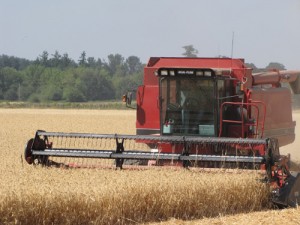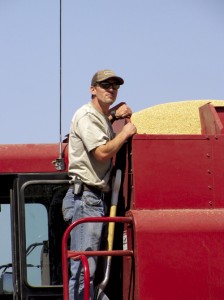Dust billows and chaff flies behind the roaring machine that full-time, second-generation farmer Ryan Eder is using to harvest a local wheat field. “I am just helping out a neighbor,” said Eder, who raises other crops as well as wheat.
Soon the combine is full and Eder heads over to the waiting semi-truck to deposit the golden grain into a trailer. Oregon farmers raised about 965,000 acres of wheat this year.
In recent years, with low international wheat prices, farmers in the USA started to change to more profitable crops. But that may soon change.
Russia, which is a large producer of wheat worldwide, is experiencing its hottest summer in the past 130 years and wildfires are now sweeping into farmlands. The harsh weather has destroyed one-fifth of this year’s wheat crop in Russia, which is currently the world’s third major exporter of the grain.
Combined with the low harvest of wheat in Canada this summer, wheat may be a choice of many Oregon farmers this upcoming year.
“The price of wheat is up, but I guess it is still a soft market as of yet,” Wilco crop consultant Tim Aman said.
“In Oregon it is about $5.80 a bushel, although back east it has hit $7- $8 a bushel. The grass-seed farmers planted wheat as a replacement when the grass seed market hit bottom due to the economy, because not as many builders, golf courses and nurseries were needing seed.”
Wheat normally needs between 110 and 130 days between planting and harvest, depending upon climate, seed type and soil conditions; and parts of Oregon are ideal for wheat production. According to the Wheat Council, about 70 percent of the wheat planted in the United States is winter wheat, which is fall planted.
Of the remaining wheat acreage, 24 percent is planted to spring wheat and 6 percent to durum. Although five major classes of wheat are grown in the United States, the two major wheats are hardred spring and hardred winter, which are both bread wheats.
“Wheat was an easy conversion for the grass-seed guys as they already had the equipment for planting, the combines and tractors for seeding and harvesting, so it worked out right,” Eder said. “Nice to see more acres of wheat being planted, it’s good for the farmers. This is the first big year, although the farmers back east are getting a higher price for it. If the Russian farmers do not get timely rains, they will either not plant or they chance to lose their crop.”
Wheat is used mainly as a human food, due to it’s nutritional content, is easily stored and transported and easily processed into various types of food.
“Wheat being planted is good for farmers, it makes harvest better and a little bit more exciting with the price of the product going up,” Eder said.
